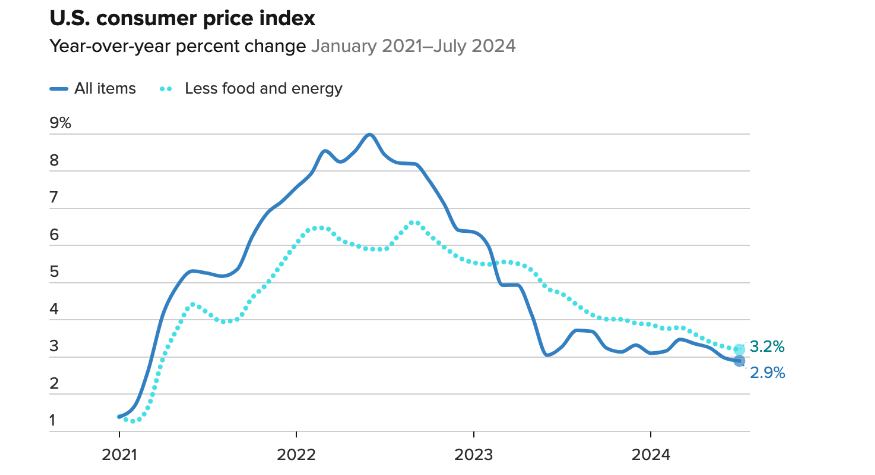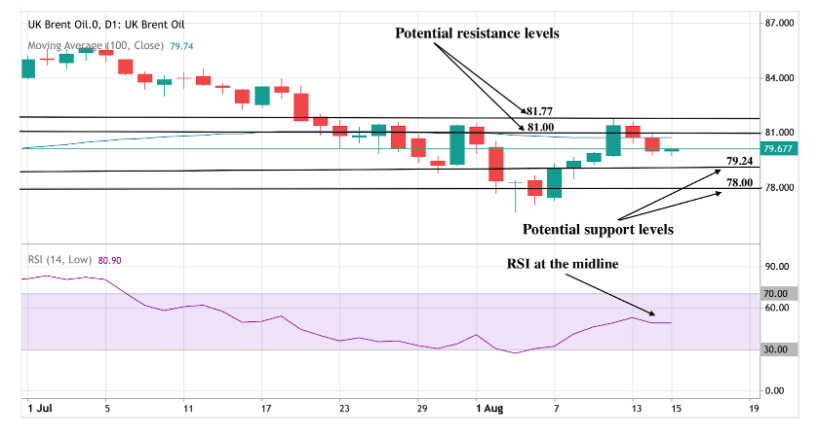Oil rises as rate cut seems imminent
Oil prices experienced a gentle recovery on Thursday, with Brent crude futures reaching $79.93 per barrel and US West Texas Intermediate crude climbing to $77.19 per barrel. This recovery followed a 1% decline on Wednesday, a drop spurred by unanticipated gains in US crude inventories and subsiding apprehensions about a wider conflict in the Middle East.
In tandem with these events, the US consumer price index (CPI) data revealed a modest inflation of 2.9% in July, the lowest since March 2021. The figure, primarily affected by rising housing costs while food and energy prices stayed relatively steady, bolstered the likelihood of a possible interest rate cut by the Federal Reserve. This CPI data reinforced Tuesday's producer price index (PPI) results, which also came in lower than expected, signaling diminishing inflationary pressures in the US economy according to the U.S. Bureau of Labor Statistics.

Source: U.S Bureau of labor statistics
Middle East tensions and China's economic concerns
Geopolitical tensions surrounding Iran’s possible reaction to last month's assassination of a Hamas leader further supported oil prices. Senior Iranian officials have suggested that only a ceasefire in Gaza would deter Iran from retaliating directly against Israel. This uncertainty has spurred increased options trading activity, as market participants seek to hedge against significant price hikes.
Nonetheless, worries about slower global demand, particularly from China, tempered these gains. In July, China's factory output growth decelerated, and refinery output fell for the fourth consecutive month, underscoring the country's patchy economic recovery. Earlier this week, the International Energy Agency downgraded its 2025 oil demand growth forecast, citing the adverse effect of China's sluggish economy on consumption. Similarly, OPEC reduced its demand forecast for 2024 due to analogous concerns.
Oil market dynamics
The oil market remains highly dynamic, influenced by a confluence of factors. While optimism around potential US interest rate cuts and geopolitical risks provided some upward pressure, concerns over sluggish global demand, especially from China, continued to weigh on the market. The recent CPI data, indicating a lower-than-expected increase of 2.9%, brings clarity, reinforcing the likelihood of a rate cut.
This closer alignment with the Federal Reserve's 2% target could have mixed implications for oil prices. On one hand, lower interest rates may weaken the US dollar, making oil cheaper for buyers using other currencies and potentially boosting demand. On the other hand, it may also signal a deceleration in the US economy, which could dampen oil demand. The interplay of these elements will continue to shape oil prices in the coming days, with keen attention on developments in the Middle East and their potential impact on an already volatile market environment.
Oil technical analysis: Will the rally hold?
At the time of writing, oil prices are edging up at around $79.67, though some sell-side pressure is evident as prices stay below 100-day moving average. Upward volatility could be tempered as the flat midline RSI suggests waning momentum. A move up could find resistance at the $81 psychological level, with a breach past that wall likely to find resistance at the $81.77 mark. On the downside, a dip below current levels could find support at the $79.24 mark and the $78 psychological level.

Source: Deriv MT5
Disclaimer: The information contained within this article is for educational purposes only and is not intended as financial or investment advice. It is considered accurate and correct at the date of publication. Changes in circumstances after the time of publication may impact the accuracy of the information. The performance figures quoted refer to the past, and past performance is not a guarantee of future performance or a reliable guide to future performance. No representation or warranty is given as to the accuracy or completeness of this information. Do your own research before making any trading decisions.





















